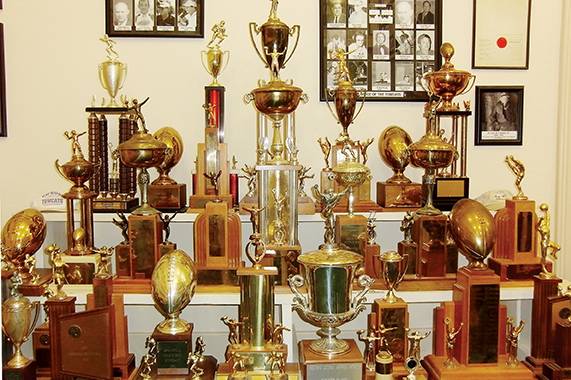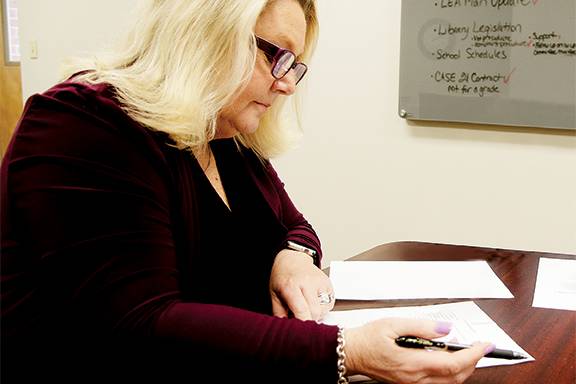The Lights of a Colorful Faith Community: Stories of the Shared History in Stained Glass

1999 – Journalist, local historian and humorist Mary Ann Veirs Lindsay (1939-2017), whose family have been members of First United Methodist Church in Brownsville for many generations, was asked to write the history of the church on the 100th anniversary of the completion of the current church structure that houses the sanctuary. Lindsay compiled records and oral accounts in her written history. She and Fred Silverstein, who writes in this magazine about the windows at Temple Adas Israel, agree on the salient point: the two communities of faith shared worship space while German artisans constructed the magnificent windows in both buildings.
“The Methodist Church, Brownsville, Tennessee 1824-1900” records that $1,537 was paid to J. J. Wagner for the windows. As people told what they remembered hearing about the windows, several pieces of a story emerged, but Mr. Wagner’s name was not in any of them. These story fragments are presented as the only clues we have to the mysteries of how we got these beautiful windows and the origin of the glass.
The first account comes from a handwritten piece that Mrs. T. J. Pearson gave to Mrs. Jerry Mize (Mary). Mrs. Pearson oversaw the Primary Sunday School Department for many years, and she often brought the little children into the sanctuary and told them about the windows. Her main objective, however, was not to give a detailed history but to teach a Bible lesson using the pictures and the symbols that the children could understand. Mrs. Pearson wrote the following:
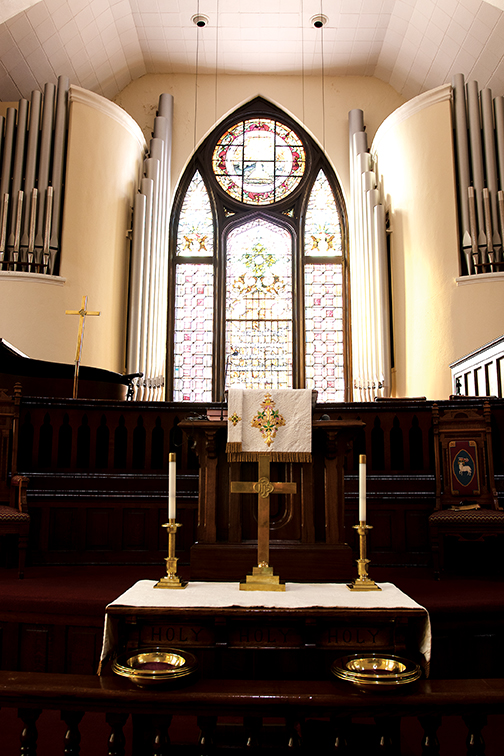
One morning, Mr. George Lyle was at breakfast when the doorbell rang. When he answered the bell, he found a man standing there who looked as if he had slept in his clothes. He really had, and he had no money to buy his breakfast. But he assured Mr. Lyle that he was a worker in fine windows and if they’d let him, he would make some lovely ones, but he would have to have money in advance so he could eat. Mr. Lyle was not sure that he wasn’t a tramp, but he trusted the man, and there are no prettier windows anywhere in the state in a church the size of ours.”
The next account is taken from a taped interview with Mr. Morton Felsenthal, and it is the story his parents told him. “Two men came from St. Louis by train. They spoke very little English, but when they got off the train and walked up Depot Hill, they felt right at home because they recognized the German Jewish names Rothschild, Felsenthal, Sternberger, Tamm and others which they saw on the stores around the square. They could talk to these storekeepers because the storekeepers had been born in Germany. The men explained their business, and they had a piece of paper with ‘Methodist Church—Brownsville, Tennessee’ written on it. The Jewish storekeepers became their interpreters and took them to the Board members in charge, and they made their contract. The men did all the work right there at the church—all by hand. While this work was being done, the Methodists worshipped in the Jewish Temple. When the church was finished, the Jewish people were so impressed they had the men put stained glass windows in the Temple. While the men were working on the Temple, the Jewish congregation worshipped in the Methodist Church.”*
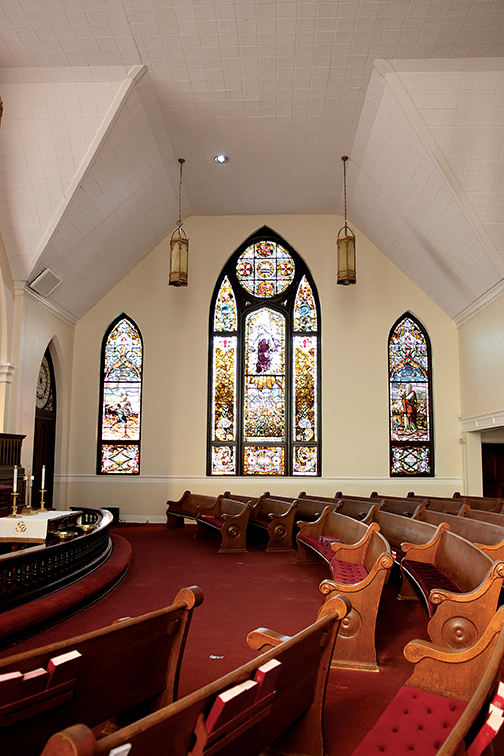
Mr. Roy Bridgewater said that Mr. W. T. Taylor told him that, while the church was being built, a man came to Mr. George Lyle and said he could put beautiful windows in the church. The man did not look well and told Mr. Lyle that he worked for years as a lead burner, i.e., he leaded glass. He had contracted lead poisoning, and, because his doctors had told him to stay in the fresh air as much as possible, he had become something of a wanderer. He desperately needed money, and he could work on this church because it was still under construction and, therefore, mostly open. The man knew where to get the glass, and he did the work right at the church.
Mr. and Mrs. George Lyle provided living quarters for the man, and he made a stained-glass window for their home. Mrs. Andy (Evelyn) Anderson lived in that house (in 1999) and the window is still there. He also made two windows for the Wilder home, owned (in 1999) by Mrs. LaJeanne Black (in 2023, owned by Milton Black), and for the Marks home, which was on the NW comer of Jackson and Franklin streets.
Mrs. Will Ford High (Emmie Tanner Mann) told this story: She and about 25 other young ladies were members of Mr. George Lyle’s Sunday School class for several years. Mr. Lyle told the class that while the church was being built, he made a business trip by train to Chicago. On the train, he met two men who represented a firm that installed fine stained-glass windows. The men showed Mr. Lyle pictures of their windows, and he was greatly impressed with them. When they told Mr. Lyle how much the windows cost, he knew the church could not afford them, but he kept thinking how beautiful windows like those he saw in the pictures would be in our church. The following morning, he approached the man and strongly suggested that if they would install windows in our church at a “special price,” their company could use this church as a showplace for their work in this area. They finally decided that this would be a good arrangement, and that’s how we got our windows. Mrs. High didn’t remember the names of the men on the train or their company.
Mrs. Bill Baldy (Panny Sorrell) said that her mother, Lucy Howell Sorrell remembered that the man who installed our windows was a German, and the glass came from Germany. Mrs. Sorrell was sure that the man installed stained-glass windows in an old Presbyterian Church in Nashville. Mrs. R. C. Hawkins (Carolyn Walker) called the downtown Presbyterian Church in Nashville and was told that their windows were installed between 1880-1883 at a cost of $1,000, and the workman was named J. J. Wagner. Unfortunately, that church’s old records have been lost, and they know nothing about Mr. Wagner or from where their glass came.
Another story fragment relates that the studio in Germany where the glass was made was destroyed during World War I and the formulas for making the glass were lost.
Dr. T. C. Chapman said that the memorial inscriptions could be bought for $25 and covered only the small windows on which they were written.
The Memphis Conference of the United Methodist Church, at the suggestion and under the direction of the Rev. W. J. Johnson, raised $236 and put in the church a beautiful window to the memory of Judge A. D. Bright, longtime faithful friend of the superannuated preachers, widows and orphans of the Memphis Conference
Miss Bess Fain said that many people gave money for the windows but did not get any “credit” for it. Mrs. Mildred Reid remembered Mrs. Fred Lyle (Matt Neblet) saying that some members felt the windows were worthy of some very personal sacrifice. “Miss Matt” sold her wedding dress and gave that money to help pay for the windows.
Mrs. Philip Williams (Martha Jane) said that Mr. George Lyle told her that when he was unable to convince the congregation that the windows would be worth the investment, he personally underwrote their cost—subject to their acceptance after installation. The finished windows were so lovely there was no further doubt, and contributions came from many sources.
The small, inscribed windows on the north and south sides of the sanctuary are known as ventilators because they could be opened during hot weather to allow some circulation of air into the church. There are also ventilators at the tops of the windows alongside the big center windows. These used to have chains on them, and they could be opened by catching the chains with a long hook and pulling them down so that the tops of the windows tilted into the sanctuary and the bottoms of the windows swung out.
Mr. Jim McCready of Hauser Studios of Stained Glass in Winona, Minnesota, said that a lot of stained glass came into this country from Germany about the turn of the century. The main ports of entry were New York and St. Louis. Glassmaking was usually a family concern, and the color formulas were handed down from generation to generation as closely guarded secrets. Sometimes, family members came with the glass to the promised land that was America. These people were craftsmen in the art of making, leading and installing the glass. Some windows were signed with the name of a family or a city, but occasionally they were not signed at all. When they were signed, the signatures were on small, inconspicuous pieces of glass because the glassmakers’ names were never to be as important as their work. Their work was their glory.
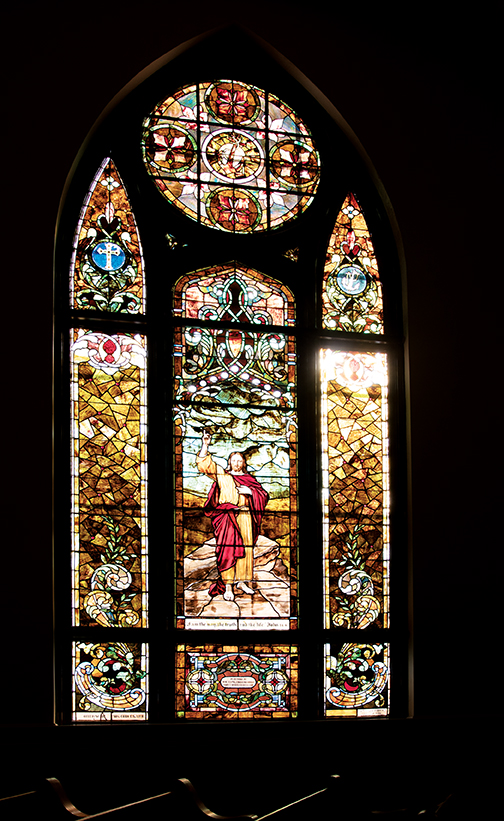

No signature has been found on any of our windows.
Mr. McCready said that if his company were to reproduce our windows at 1982 production prices, the glass would cost between $185 to $200 per square foot. He also stated that our windows could be coped but never replaced.
Perhaps the real truths are to be rediscovered by each generation—that the windows stand as a testament to the beauty that God and man were meant to create together. Man’s greatest glory lies in doing God’s work well.
As glorious as these windows are, in the darkness they seem to sleep. As they stand in repose, holding the glorious potential that was created in them, they wait for the light. It is the light that gives them life.
Think of the glass coming from Europe to this country and then to Brownsville. Here, it had to be cut and leaded. Forms had to be made, the lead heated until it was liquid and then poured in the forms around the pieces of glass. Then it all had to be put into the window openings, and it had to fit exactly. The weight and stress had to be distributed so that the windows did not crush themselves. The molding was then fitted around the openings. The engineering know-how and sheer physical labor that it took to install these windows staggers the mind. Add to that the miles the glass covered coming from Germany to Brownsville. Add to that the craftsmanship, time and effort it took to make the glass itself, and then paint the scenes on it, pack it to travel thousands of miles without breaking, and do all this in the 1890s. We know nothing of the people who gave hour after hour of their lives to make and install them. One of the strangest things about these windows is that we know so little about them. Nobody remembers when they were being installed. Didn’t someone ask about them? Didn’t anyone tell their children the story? The answer seems to be, “No.”
*See Fred Silverstein’s article “The Stained Glass Windows of Temple Adas Israel: “Unique, Beautiful, and Filled with the Spirit of God,” in this magazine for information about the shared stained-glass treasures of Brownsville.

